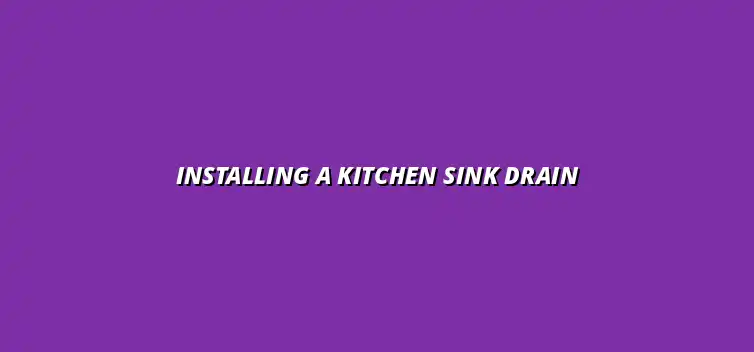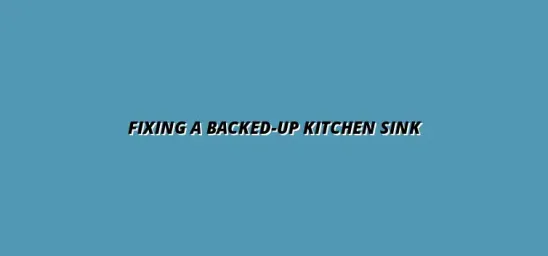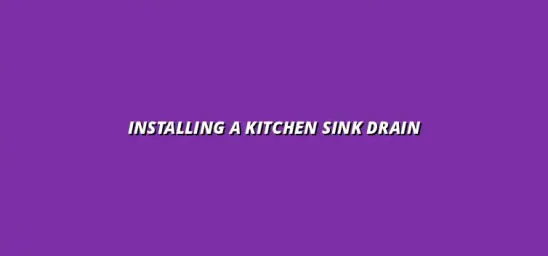
Installing a Kitchen Sink Drain
Understanding the Importance of Kitchen Sink Drain Installation
When it comes to a functional kitchen, the importance of a well-installed sink drain cannot be overstated. It's the unsung hero behind your daily routines, ensuring that water drains away efficiently. A properly functioning kitchen sink drain keeps your space clean and hygienic, while also preventing unpleasant odors and potential water damage.
In addition to maintaining cleanliness, an efficient drain system is essential for overall kitchen efficiency. If your sink drain is not working correctly, it can cause backups, slow drainage, and even leaks. These issues not only disrupt your cooking activities but can also lead to more significant plumbing problems down the line. Addressing these issues promptly is crucial, and sometimes, you might need professional help, such as a plumber in Billesley, Birmingham, to handle complex situations.
Overview of Kitchen Sink Drain Functions
The primary function of a kitchen sink drain is to remove wastewater from the sink and transport it to the home’s plumbing system. This includes everything from dirty dishwater to leftover food particles. Understanding this function is vital for any homeowner looking to install or replace a kitchen sink drain.
Beyond just drainage, the sink drain also plays a role in preventing clogs through its design, such as the incorporation of strainers. These components help catch debris before it reaches the pipes, making maintenance easier. A well-chosen drain system can make a significant difference in how smooth the kitchen operation feels. Learning how to unclog your sink with ease is a valuable skill for every homeowner.
Role of Drainage in Kitchen Efficiency
Effective drainage helps avoid water pooling around the sink area, which can lead to unpleasant situations. If your sink drains quickly and smoothly, it allows you to focus on cooking and cleaning rather than dealing with plumbing issues. A good drain allows for quick cleanup of spills, making your kitchen a more functional and enjoyable space.
Moreover, when your drainage is functioning well, it contributes to better overall hygiene. Standing water can attract pests and create odor problems. By ensuring efficient drainage, your kitchen remains a welcoming environment for cooking and family gatherings! Regular cleaning of your kitchen drain lines is important to maintain this efficiency; you can find helpful tips on how to clean kitchen drain lines easily.
Common Issues with Old Kitchen Sink Drains
Older kitchen sink drains often come with a host of problems that can hinder their performance. Some common issues include slow drainage, frequent clogs, and even leaks. These problems can stem from age, wear, and tear, or the accumulation of debris over time.
Another frequent problem with old drains is corrosion, especially if they are made of metal. This can lead to rusting and ultimately cause leaks. Addressing these issues early can save you from significant repairs later on, so it’s essential to stay vigilant! For instance, learning how to fix kitchen sink leaks with a DIY guide can save you money and time.
Essential Tools and Materials for Installing a New Kitchen Sink Drain
Before diving into the installation of a new kitchen sink drain, it's crucial to gather the right tools and materials. Having everything on hand ensures a smoother installation process. Let’s take a closer look at what you’ll need to get started!
List of Required Tools
Here’s a handy list of tools and materials you’ll need for a successful kitchen sink drain installation:
- Pipe Wrench: Essential for loosening and tightening plumbing connections.
- Plumber's Putty: Used to create watertight seals.
- Screwdrivers: Both flathead and Phillips for securing drain components.
- PVC Cutters: For cutting PVC pipes to the correct length.
- Bucket: To catch any water during the installation process.
Plumbing Tools for Sink Drain Installation
In addition to the general tools mentioned, there are specialized plumbing tools that can make your installation easier. A drain auger can help if you encounter any clogs during the removal of the old drain. Having these tools ready can save you time and hassle during the installation. If you're also planning to install a new faucet, this guide on how to install a new faucet easily will be useful.
Also, consider investing in a plumber's snake. This handy tool can help you tackle stubborn blockages that might occur after installing your new drain. Preparedness is key to a successful plumbing project!
Safety Gear to Consider During Installation
Safety should always be a priority when working with plumbing. Make sure to have the necessary gear, such as:
- Protective Gloves: To keep your hands safe from sharp edges and chemicals.
- Safety Goggles: To protect your eyes from debris and splashes.
- Mask: If you're working with strong-smelling materials like plumber's putty.
Taking these precautions will help keep you safe while ensuring that your installation goes off without a hitch!
Choosing the Right Drain Components
Choosing the correct drain components is pivotal in ensuring your sink works efficiently. Think about your kitchen’s design and your specific needs when selecting parts. Let’s explore some options!
Types of Kitchen Sink Drains Available
There are various types of kitchen sink drains available on the market, each designed with specific features. Here are some common types:
- Standard Sink Drains: Basic drains that work for most situations.
- Strainer Sink Drains: These include a built-in strainer to prevent clogging.
- Disposal Drains: Designed for homes with garbage disposals.
Choosing the right type can depend on your cooking habits and preferences. If you often cook with heavier ingredients, a strainer drain might be the best fit! If you encounter a clogged kitchen sink, check out this guide on fixing a clogged kitchen sink.
Materials: Plastic vs. Metal Drains
When it comes to materials, you generally have two options: plastic or metal. Plastic drains are often lightweight and resistant to corrosion, making them a popular choice. However, metal drains, such as those made from stainless steel, offer durability and a sleek look.
Here’s a quick comparison of the two:
| Material | Pros | Cons |
|---|---|---|
| Plastic | Lightweight, corrosion-resistant | Can warp over time |
| Metal | Durable, stylish | Can rust if not maintained |
Consider your needs and preferences to choose the best material for your kitchen sink drain! Installing a bathroom sink trap is a similar process, and you might find this guide useful: Install a bathroom sink trap easily.
Troubleshooting Common Kitchen Sink Drain Issues
Even with the best installation practices, kitchen sink drains can sometimes run into problems. This part of the project is all about recognizing the signs of trouble and knowing how to fix them. It’s important to address these issues promptly to avoid further complications and maintain the efficiency of your kitchen.
Common problems can range from slow drainage to unpleasant odors. By understanding these issues, you can ensure your kitchen remains a functional and pleasant space. Let’s explore the signs of poor drainage and what you can do about them!
Identifying and Resolving Drainage Problems
Recognizing the signs of poor drain functionality is crucial for maintaining your kitchen. Some indicators include:
- Slow draining water: Water takes longer than usual to go down the sink.
- Unpleasant smells: Foul odors can indicate trapped food particles.
- Gurgling sounds: Weird noises often point to blocked pipes.
- Frequent backups: Water bubbling back up into the sink is a clear sign of trouble.
If you notice any of these signs, it's time to investigate further. Look for blockages that may be causing the issues and try to resolve them as soon as possible.
Signs of Poor Drain Functionality
Drain issues can be a nuisance, and some signs are more obvious than others. You might want to keep an eye out for:
- Water pooling: If water collects in the sink, it’s a clear indication of a drainage problem.
- Drain flies: These little pests often breed in slow or stagnant water.
- Frequent clogs: If you’re constantly clearing blockages, it’s time to take action.
Identifying these signs early can help prevent major plumbing issues down the road!
Solutions for Common Drain Issues
Once you’ve pinpointed the problem, you can start implementing solutions to fix your kitchen drain. Here are some effective strategies:
- Use a plunger to dislodge clogs.
- Try a natural drain cleaner, like baking soda and vinegar.
- Check and clean the P-trap for built-up debris.
- If all else fails, consider calling a professional plumber.
Staying proactive about your kitchen sink drain will lead to a smoother-running kitchen!
FAQs About Kitchen Sink Drain Installation
Many common questions arise when it comes to kitchen sink drain installation. Here are some frequently asked questions and their answers.
What Should I Do If My Sink Drains Slowly?
If your sink is draining slowly, there are several steps you can take:
- Check for visible clogs in the drain.
- Use a plunger to help clear the blockage.
- Run hot water down the drain to see if it helps.
- If the problem persists, consider using a plumbing snake.
Taking these actions can help restore proper drainage!
How Often Should I Replace My Kitchen Sink Drain?
It’s recommended to replace your kitchen sink drain every 5 to 10 years, but this can vary based on usage and maintenance. Here are some factors to consider:
- Look for signs of wear or corrosion.
- Consider how often your kitchen sink is used.
- Evaluate any previous plumbing issues.
By keeping an eye on your sink drain's condition, you can determine the best time for replacement.
Maintaining Your New Kitchen Sink Drain for Longevity
After installing your new kitchen sink drain, it’s essential to keep it in great shape. Regular maintenance will help ensure optimal performance and reduce the likelihood of future problems.
With a few simple tips, you can maintain your drain and keep your kitchen running smoothly for years to come!
Best Practices for Regular Drain Maintenance
Regular maintenance is key to avoiding clogs and blockages in your kitchen sink drain. Here are some best practices to follow:
- Flush the drain with hot water once a week.
- Use a strainer to catch food particles and debris.
- Avoid pouring grease down the sink.
- Schedule an annual drain cleaning to prevent buildup.
By incorporating these habits into your routine, you can help prevent drain problems before they start!
Cleaning Tips to Avoid Clogs and Build-Up
Cleaning your sink drain regularly is essential for avoiding clogs. Here are a few effective cleaning tips:
- Mix equal parts baking soda and vinegar to clean the drain.
- Use a plumbing snake to remove stubborn blockages.
- Run boiling water down the drain after each use to keep it clear.
These easy steps can help maintain your drain’s health!
When to Seek Professional Help for Drain Issues
Sometimes, despite your best efforts, drain issues can persist. If you find yourself in any of these situations, it’s time to call a professional:
- Repeated clogs that don’t respond to DIY methods.
- Unexpected wet spots or water damage in your kitchen.
- Unpleasant odors that won’t go away.
Seeking help early can save you from bigger problems down the line!
Considerations for Future Kitchen Renovations
If you’re thinking about renovating your kitchen, it’s a great time to consider your sink drain setup. Planning ahead can save you hassle and money!
Whether it’s upgrading your sink or changing the plumbing layout, being mindful of drainage is essential for any kitchen renovation.
Planning for Sink Drain Upgrades During Remodeling
When planning a renovation, think about how these upgrades can improve your kitchen’s functionality:
- Installing a larger sink with a more efficient drain.
- Adding a garbage disposal for easier food waste management.
- Updating to modern drain materials that resist corrosion.
These changes can significantly enhance your kitchen's efficiency and longevity!
Understanding New Technologies in Kitchen Drain Systems
Kitchen drain technology is always evolving, and keeping up with new trends can be beneficial. Here’s what to consider:
- Smart drains that alert you to clogs.
- Eco-friendly plumbing options that save water.
- Upgraded drain systems that improve overall performance.
Staying informed about the latest technologies can help you make the best decisions for your kitchen!
Final Thoughts on Installing a New Kitchen Sink Drain
Installing a new kitchen sink drain may seem daunting, but with the right knowledge, you can tackle it successfully. Recapping the key steps ensures you cover everything necessary for a smooth installation.
Don't be afraid to take on DIY plumbing projects! With a bit of effort and the right guidance, you can achieve great results!





Fixing a Backed-Up Kitchen Sink
Prepare Your Plumbing for Weather
Installing a Kitchen Sink Drain
When to Replace Plumbing Fixtures
Fixing a Jammed Garbage Disposal